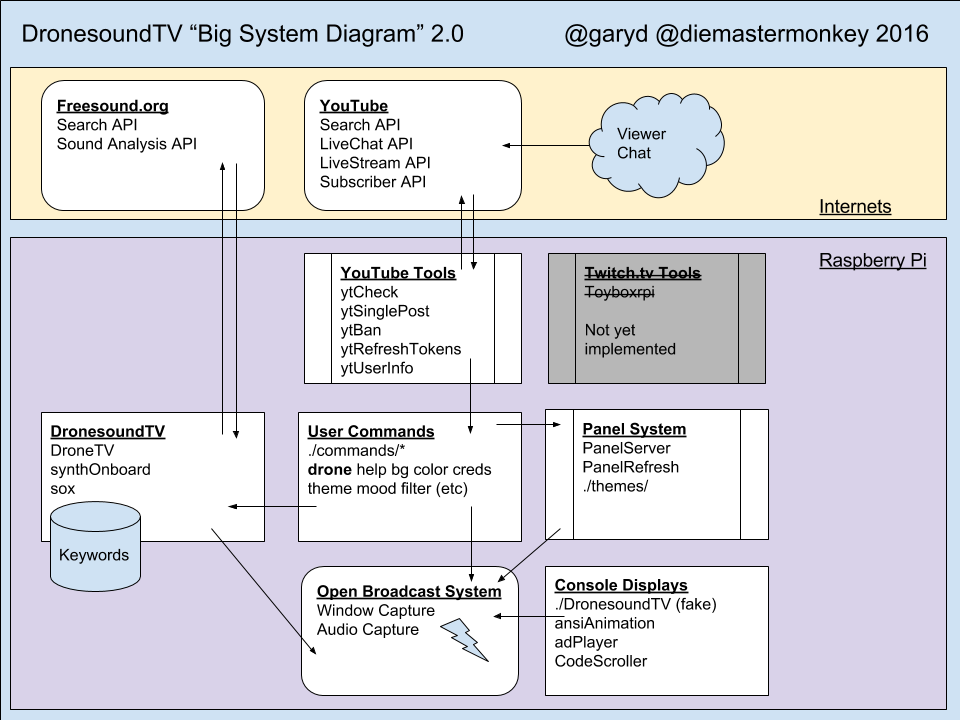Oh boy it's been too long since I posted an update. I'll apologize for that but not for the reason: I've been "heads-down" working full-bore on DronesoundTV the whole time.
And I've got to get back to that right away, but first you deserve some details about happenings.
The Live Stream
Remember the project moving to its own channel on YouTube. It's probably live right now:
Big Diagram 2.0
Since last I reported-in, DronesoundTV has come a long way. While my earlier diagram remains applicable, it covers only the most superficial details of the "Dronesound" part of this project. My efforts since then have focused on the "TV" part.

The diagram shows how much the system has expanded - note that the generation of sound still conforms to the earlier "What Makes a Sound" diagram.
As before, viewers user YouTube chat to add sounds to the audio mix.
However, they now have many additional powers including:
- Changing the color, background image
- Choose from a variety of visual layouts ("themes")
- Apply and adjust a "low pass filter"
- Choose from several complete sound "moods"
- Import animated GIFs for the stream's ANSI displays
Moods
One of the most important additions is the "moods". As I stated early-on, the historical model for the project are the "ambient sound" machines that generate white noise, ocean sounds, et cetera. While this clearly aims to go much further, I still intend to meet or exceed the function provided by those primitive earlier solutions.
With the "mood" command, viewers switch between pre-configured sets of keywords designed to evoke a particular audio theme. Most of them are places, for instance "arcade" or "seashore".
Using the mood command loads a carefully-edited set of up to 200 keywords (and sound designers). For example, the arcade mood includes keywords such as pinball, retro, videogame, williams, bally, atari, cheering, and pachinko. The seashore mood contains instead such things as beach, shore, waves, boat, seagulls, whalesong, and thunder.
Yes the number of moods will grow and their quality will improve, but the real destination here is infinite customization - so of course each viewer will have their own "my mood" to configure to their liking.
Panel System
Do me a favor and go check out the DronesoundTV Live Stream real quick. Unless it's down (which is rare) in which case you could check out a replay will have to do.
Okay, so you see that layout? No, it's not exactly the height of modern UI design but that's not the point.
It's all HTML and CSS.
See, I'm an actual live video streamer on Twitch (where I do live beat sets). And like many budget streamers, I use OBS (the Open Broadcast Suite). While I'm grateful for OBS, it (and most other streaming solutions) are an absolute nightmare if you want a really nice layout.
Editing layouts is done in the software with proprietary tools. Images have to be imported, camera views meticulously positioned - the entire process is beyond painful and nothing any performer is (or needs to be) good at.
Well, screw that. I'm tired of limited layout choices. The "panel" system lets users (and me) change the on-screen layout and even the contents - directly from chat.
And being simply a web page, literally anything is now possible: My layouts can include animations, AJAX integration, user interactions - anything I can do in a web page.
I know....it's whack. ;)
This is becoming the most exciting part of the project, and will have tremendous relevance to the parent "Internet Toybox/Stage Ghost" project. Stay tuned for rapid development on this front.
New Geek Sesh Video!
If you want to see some this in action along with an old geek explaining it, haltingly, with occasional diversions - then this video is for you.
Code Dump Pending
Yes, the code on GITHub is woefully behind. One look at it will tell you it couldn't be responsible for everything in that new diagram.
I will be releasing the latest (much cleaner) DronesoundTV code soon, but still need to work to make it possible to use without all of the new tentacles. At the moment, there is too tight a coupling between the sound engine and the YouTube, FreeSound and other ancillary components to release the code separately.
Bonus: Crash and Recovery, Live
Fun bonus clip! Watch a rare DronesoundTV crash - which looks bizarre - and recovery assisted by live lo-fi beats.
 Die, Master Monkey!
Die, Master Monkey!
Discussions
Become a Hackaday.io Member
Create an account to leave a comment. Already have an account? Log In.